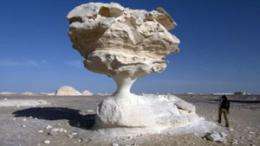The secrets of the Sahara revealed

"When I first arrived in the Sahara, I was struck by how utterly barren it was, like the color green was removed from the palette when they made this place, just nothing, grays and browns, and not a scrap of life," Jennifer Smith says at the beginning of a History TV channel documentary on the Sahara.
Smith, Ph.D., associate professor of earth and planetary sciences in Arts & Sciences at Washington University in St. Louis, is setting up an astonishing revelation: The bone dry Sahara we know today hides a wet, occasionally dripping-wet, geologic past. In fact, there are still giant aquifers beneath the sand that hold as much fresh water as the Great Lakes.
So the Sahara is a geological mystery. To figure out what happened and why, Smith and her colleagues must follow a trail of improbable clues that include marine fossils in the pyramids, fossil whales in a remote wadi, or dry valley, Saharan sand in deep ocean cores, and paintings in desert caves of people swimming.
Smith's specialty is geoarchaeology, which uses classic earth science methods and concepts to address questions of archaeological interest. She is particularly interested in the climate in North Africa during the past few hundred thousand years, when it seems to have alternated between savannah and desert. Her work suggests, among other things, that periodic humid conditions throughout the Sahara may have enabled the movement of modern humans out of Africa to Europe and Asia.
The documentary airs Jan. 19 at 12:00 p.m. and again at 6 p.m CST.
In the first section of the documentary, part of the History (formerly The History Channel) series "How the Earth was Made," Smith takes the viewers to the Great pyramid of Giza, where she shows them ancient marine fossils called nummulites, a diminutive form of the Latin nummulus meaning "little coin," embedded in the blocks that make up the pyramids.
Where did these marine fossils come from?
Smith next takes the viewers to Wadi al-Hitan (Valley of the Whales) where the rocks are the same age as those from which the pyramid blocks were quarried. There she shows the viewers the fossil skeleton of a 21-foot whale. The wadi has a remarkably high concentration of fossils, and almost all of them are marine animals.
What are whales doing in the desert?
After revealing the astonishing answer to that question, Smith and her colleagues set off to solve two more Saharan mysteries: when, exactly, did the Sahara become a desert, and why, after that cataclysmic event, has it oscillated between grassland and wasteland roughly every 20,000 years?
The last swing of the pendulum, which took place about 5,500 years ago, is particularly poignant because farmers had settled parts of the then green Sahara. They scratched into the wall of a Libyan cave a cloud unleashing long streaks of rain. But this supplication in stone went unheard and unanswered -- the rains failed, and the people disappeared.
At the end of the film, Smith takes the viewer to see pumping stations that are drawing water from the giant aquifers beneath the desert to irrigate crops. She points out that the water spilling from the pumps is warm. Earth's temperature increases with depth so, in the absence of local volcanic activity, the water's temperature indicates it comes from deep underground, three-quarters of a mile down or deeper.
This is fossil water, Smith says, that accumulated over at least the last 1 million years. In some parts of the Egyptian desert, wells may run dry in as little as 100 years and, based on the work she and her colleagues have done, it might be another 15,000 years before they have a chance to refill.
Provided by Washington University in St. Louis















